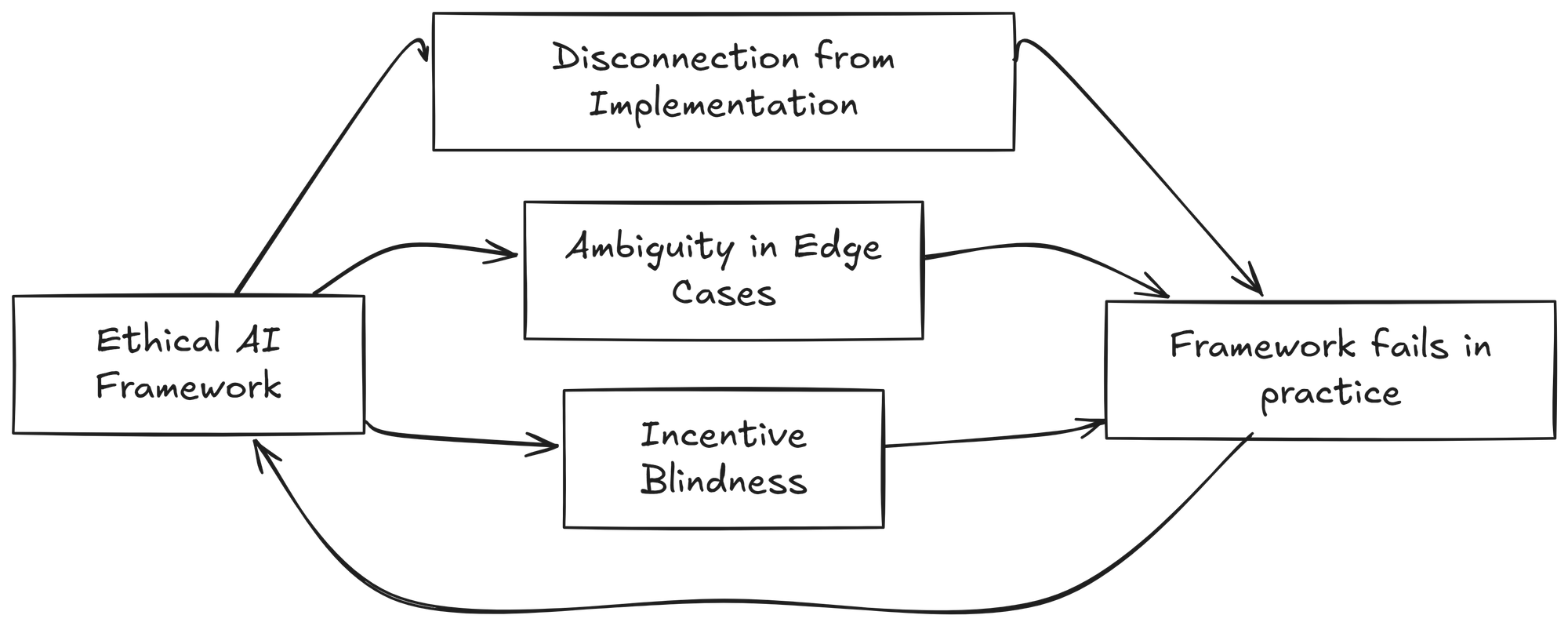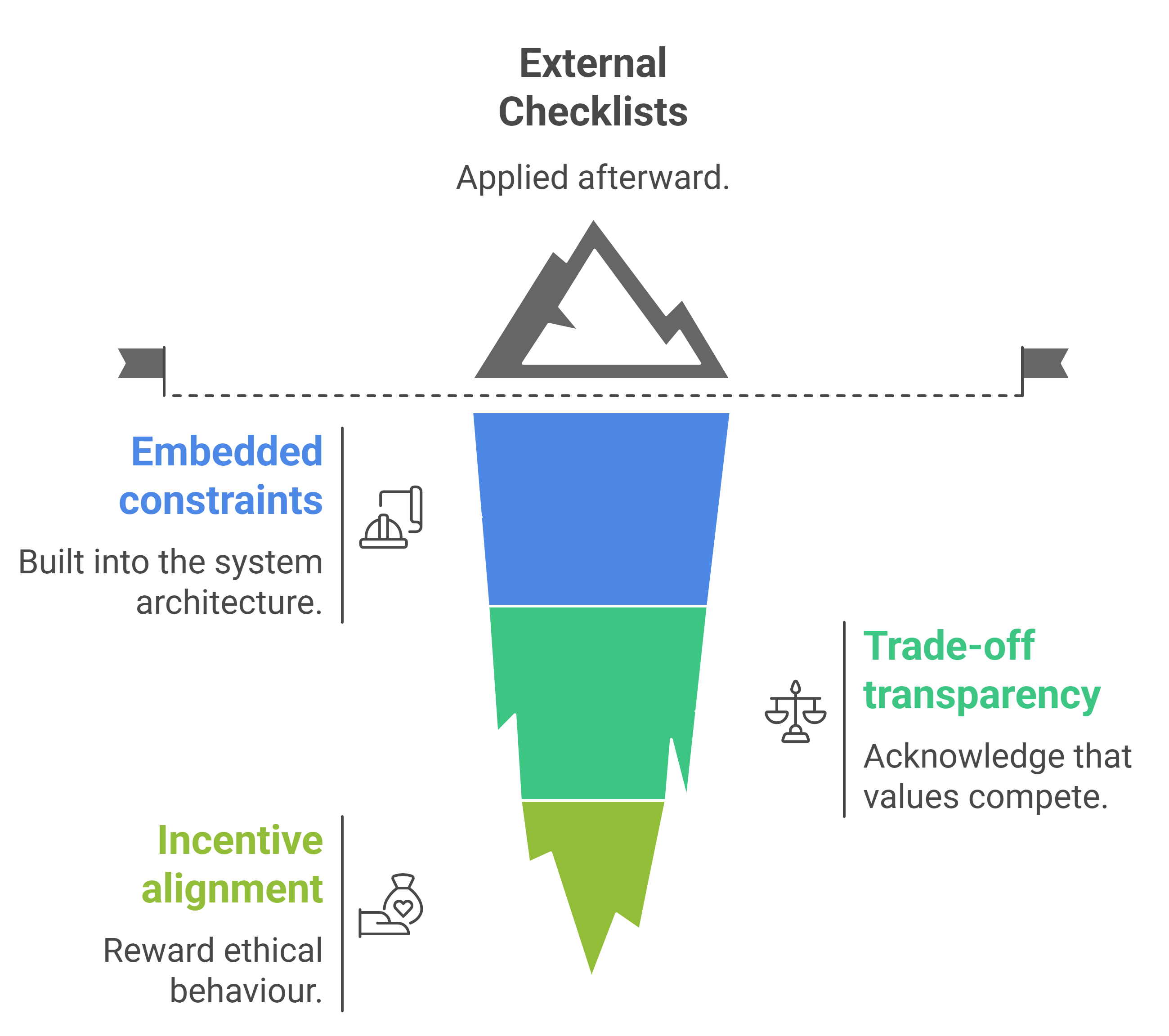The Real Reason Most Ethical AI Frameworks Fail
Most ethical AI frameworks fail for the same reason: they were never meant to survive real-world constraints.

Every few months, a new ethical AI framework drops.
It comes with a clean PDF, a good-looking chart, and the same five values: fairness, accountability, transparency, privacy, and safety.
They all sound good. They all fail the same way.
I've read enough of these frameworks to spot the pattern. Good intentions. Smart people. Careful language. And then nothing changes in the actual systems being built.
The problem isn't the values. It's everything else.
Why These Frameworks Exist
Let's be honest about what these documents actually do:
They reduce public backlash. They satisfy legal teams. They give executives something to point to when questioned about AI ethics.
Most serve as signalling mechanisms. Look, we care about ethics. We have a framework. We're responsible.
This isn't necessarily bad. Public pressure works. Legal compliance matters. Internal conversations about ethics are better than no conversations.
But frameworks don't build systems. People do.
And people respond to incentives, not PDFs.
Where They Actually Fail
Three places where good intentions meet reality and lose:

Disconnection from Implementation
Most ethical frameworks read like philosophy papers, not engineering specs.
"Be fair." "Ensure transparency." "Protect privacy."
Great. How?
The framework lives in a document. The actual system lives in code, data pipelines, and product decisions. There's no bridge between them.
You can't translate "fairness" into a function call. You can't implement "transparency" without defining what level of explanation makes sense for what type of user in what context.
The framework stays abstract. The system stays unethical.
Ambiguity in Edge Cases
"Fairness" sounds simple until you're building a credit scoring system.
Fair to whom? The borrower who wants credit? The lender who wants to avoid defaults? A society that wants equal access? Shareholders who want profit?
These interests don't align. They compete.
Most frameworks pretend these conflicts don't exist. They use words like "balance" and "consider" without defining what that means when you have to choose.
Real systems make specific trade-offs. Ethical frameworks that can't guide those trade-offs are useless.
Incentive Blindness
Here's the real problem: ethical principles without enforcement become decoration.
If your quarterly bonus depends on hitting user engagement metrics, and fairness constraints hurt engagement, guess what gets ignored.
If your product launch timeline doesn't have space for bias testing, bias testing doesn't happen.
If ethical compliance slows down feature development, and speed is how you get promoted, ethics loses.
The framework says, "Be ethical." The organisation rewards "be fast."
People follow rewards, not documents.
What Ethical AI Actually Needs
Real ethical AI requires something harder than good intentions:
Embedded constraints, not external checklists. Ethics has to be built into the system architecture, not applied afterward. It has to slow things down.
Create friction. Force difficult conversations before they become impossible problems.
Trade-off transparency, not trade-off denial. Good ethical frameworks acknowledge that values compete. They help you make better trade-offs, not pretend trade-offs don't exist.
Incentive alignment, not value alignment. If you want ethical behaviour, reward ethical behaviour. Measure it. Promote people who prioritise it. Make it expensive to ignore.
The best ethical frameworks don't prevent tension. They force it to become visible early, before the damage compounds.

Why This Is So Hard
I have empathy for people trying to build ethical AI systems. Because the constraints are real:
Values collide in practice. Privacy vs. personalisation. Fairness vs. accuracy. Transparency vs. competitive advantage. You can't optimise for everything.
Context changes faster than regulation. What's ethical in healthcare AI might not be ethical in financial AI. What works in one culture might fail in another.
Business pressure is constant. Ethical systems often take longer to build, cost more to maintain, and perform worse on simple metrics.
Ethics in AI isn't a checklist. It's a constraint that has to shape architecture, not just communications.
That's why most frameworks fail. They're designed for the easy case, not the hard one.
Why I'm Writing About This
I work in systems where ethical failure isn't academic. It's operational.
In finance, an unfair algorithm doesn't just create a bad user experience. It creates real harm. Denied loans. Missed opportunities. Broken trust.
In AI systems that make decisions about people's lives, ethics isn't a nice-to-have. It's the difference between systems that work and systems that break.
Trust, fairness, and accountability aren't values on a wall. They're constraints I have to build around.
This creates friction. Slows things down. Makes everything more complex.
But it also makes the end result more likely to survive contact with reality.
The Real Challenge
Most ethical AI frameworks fail because they were never meant to survive real-world constraints.
They're designed to look good in presentations, not guide difficult decisions.
The frameworks that actually work are the ones that acknowledge complexity instead of hiding from it. They create useful friction instead of philosophical comfort.
They don't solve ethics. They structure the problem so you can make better choices about which ethical failures you can live with.
Because every system fails ethically somewhere. The question is whether you choose where or let it happen randomly.
This blog is my way of exploring that constraint. Slowly. Publicly. One friction at a time.
Not because I have the answers, but because the questions are too important to leave abstract.
This space stays independent. If it sparked value, you can fuel the next one ⇢
☕ Buy me a coffee



